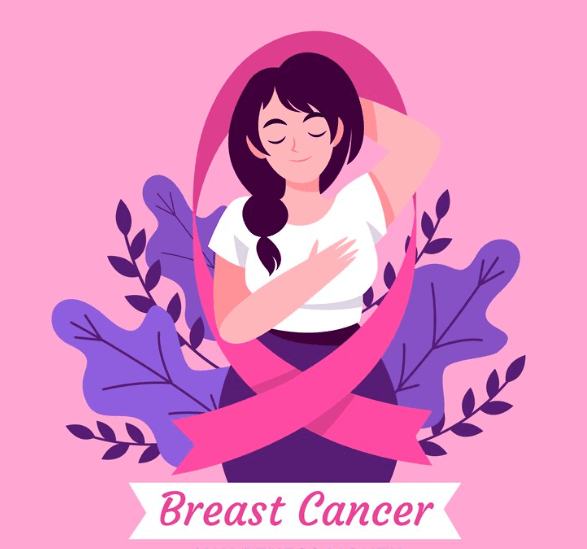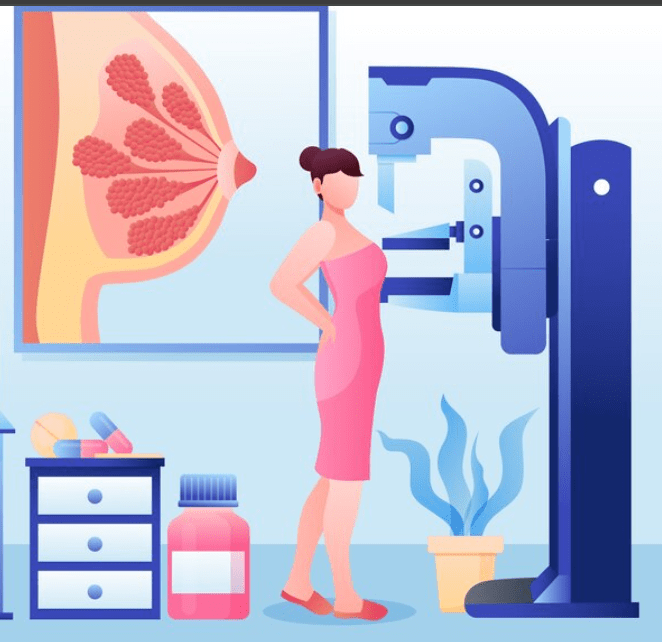How do you detect and treat breast cancer? It is very critical to detect and treat breast cancer in its early stages.
- Table of Content
- 1. Critical information cited by W H O
- 2-Types of breast cancers.
- 3-Risk Factors
- 4-Signs and symptoms
- 5–Preventive examination of the breast for cancer.
- 6–Investigations
- 7–Preventive steps for Breast cancers
- 8-Treatment
- 8.1: Surgery: Lumpectomy or mastectomy
- 8.2; Radiation therapy
- 8.3:Chemotherapy
- 9- Summary
1. Critical information cited by W H O
- Breast cancer caused about 670,000 deaths globally in 2022.
- Roughly half of all breast cancers occur in women, with no specific risk factors other than sex and age.
- Breast cancer was the most common cancer in women in 157 countries out of 185 in 2022.
- Breast cancer occurs in every country in the world.
- Approximately 0.5–1% of breast cancers occur in men.
2-Types of breast cancers
Breast cancer is a disease in which abnormal breast cells grow out of control, resulting in a mass or tumor. It can also spread to other body parts if left uncontrolled. 1. Early breast mass or cyst: Breast cancer develops when certain breast cells start to grow quickly and erratically, resulting in the formation of a lump or lobulated mass. 2. Invasive lobular carcinoma – These cancers develop in the glandular tissue of the breast or in other cells or tissues within the breast. 3: During the metastasis stage: cancer cells spread in the nearby gland or disseminate throughout the body.
3-Risk Factors
Females are the strongest breast cancer risk factor. Approximately 99% of breast cancers occur in women, and 0.5–1% of breast cancers occur in men. There are many risk factors, but having one or more risk factors does not necessarily mean one will develop breast cancer. Some women who develop breast cancer have no known risk at all.
- 3.1: Age
Like most common cancers, breast cancer rises in incidence with advancing age. - 3.2: Family History of Breast Cancer
If your mother, sister, or daughter was diagnosed with breast cancer, especially at a young age, your risk is increased. - 3.3: Inherited Breast Cancer genes
Children are more likely to develop breast cancer because their parents carry cancer genes. For this, the most responsible genes are the BRCA1 and BRCA2 genes. If they are present, they can greatly increase the risk of breast cancer and other cancers. - 3.4–Being overweight
Being obese or overweight increases the risk of breast cancer. With more body fat, your body stores more estrogen, which stimulates tumor growth. Maintain a healthy weight by being physically active and eating a healthy, balanced diet. - 3.5–Early menstruation or late menopause.
Menarche at an early age (before 12) and menopause at the age of 55, after increasing the risk of breast cancer. - 3.6–Late Pregnancy
Women who give birth to their first child after age 35 may have a slightly increased risk of breast cancer. - 3.7–No pregnancy at all: A woman who has no pregnancy or is unmarried has the risk of breast cancer.
- 3.8–Postmenopausal Hormone Replacement Therapy
Hormone replacement therapy with estrogen and progesterone in post-menopausal women may increase the risk of breast cancer.
The risk decreases when women stop taking these medications. - 3.9. Smoking and drinking alcohol both increase the risk of breast cancer, if taken heavily. 3.10–Sedentary habits
Regular physical activity reduces breast cancer risk, especially in menopausal women.
4-Signs and symptoms
Most women will not experience any symptoms when the cancer is still in its early stages; hence, the importance of early detection is very important.
Breast cancer can have a combination of symptoms, especially when it is more advanced. Symptoms of breast cancer are:
- A breast lump or thickening, often without pain
- Change in size, shape, or appearance of the breast
- Dimpling, redness, pitting, or other changes in the skin
- Change in nipple appearance or the skin surrounding the nipple (areola)
- Abnormal or bloody fluid from the nipple. 5–Preventive examination of the breast for cancer.
5.1. Self-examination of breasts: Examine and palpate both breasts up to the armpits and lower margin of the clavicles.

5.2:Examination by a health professional: Get yourself checked by a specialist doctor or nurse. They will examine both the breasts for lumps and the armpits for gland enlargement. 5.3: Frequency of examination It should be done every 3 years at ages 20–30 and every year, after the age of 40.

6-Investigations
6.1–X-ray mammogram: Both breasts are examined by the mammographic machine for any mass, irregularity, calcifications, or enlarged glands in the armpits.

6.3- FNAC exam: If there is any mass or irregular cyst. An ultrasound-guided fine needle is inserted inside the mass to take out a bit of tissue for histo-pathology exam. It will reveal the nature of the mass, whether benign or cancerous. 6.4-MRI exam– It’s a non-invasive and no-radiation exam of breasts, that reveals more details than a mammogram 6.5-PET scanning-The PET scan uses a radioactive drug called a tracer to show both typical and atypical metabolic activity It is done to find out the spread of cancerous foci outside breast in a different part of the body.
Important warning-People with an abnormal breast lump should seek medical care, even if the lump is painless.
Most breast lumps are not cancerous. They are mostly benign fibro-adenomas and may be treated by lumpectomy only.
7–Preventive steps for Breast cancers
- 7.1 Preventive Medications (chemoprevention).
Estrogen-blocking medications, reduce the risk of breast cancer in women with a high risk of the disease. Sometimes these medications have side effects also. So given with caution.
. - 7.2 Preventive Surgery
Women with a very high risk of breast cancer may choose to have their healthy breasts surgically removed (prophylactic mastectomy).
8-Treatment
Treatment for breast cancer depends on the type and stage of cancer and whether it has spread outside of the breast into lymph nodes (stages II or III) or disseminated to other parts of the body (stage IV).
Combination of treatment to minimize the chances of recurrence. These include:
- 8.1: Surgery: Lumpectomy or mastectomy to remove the breast tumor
- 8.2; Radiation therapy to reduce recurrence risk in the breast and surrounding tissues
- 8.3:Chemotherapy to kill cancer cells and prevent spread, including hormonal therapies, chemotherapy, or targeted biological therapies.
9- Summary Breast cancer is a disease, in which abnormal breast cells grow out of control, resulting in a mass or tumor. It can also spread to other body parts if left uncontrolled. Most of the women will not experience any symptoms while the cancer is still in its early stages, hence, the importance of early detection is very crucial. Satish Tripathi sctri48
